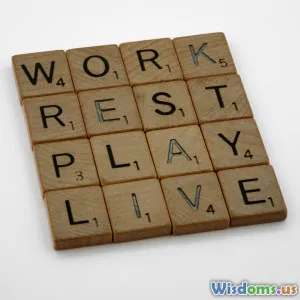
From Routine to Results: Transform Your Daily Schedule for Success
8 min read Discover how to revamp your daily routine into a powerful success-driving schedule. (0 Reviews)
From Routine to Results: Transform Your Daily Schedule for Success
Introduction
Have you ever wondered why some people seem to effortlessly achieve their goals while others struggle despite putting in long hours? The secret often lies not just in what they do, but how they organize their daily routines. A routine is more than just a series of habitual tasks — it’s a carefully structured framework that drives consistent, measurable results.
In this article, we will explore how you can transform your day-to-day routine from a stagnant list of activities into a dynamic, success-oriented schedule that propels you toward your goals. By understanding the psychology behind habits, applying time-management principles, and integrating personal productivity techniques, you can reengineer your daily life for meaningful progress.
1. The Power of a Well-Designed Routine
Routines provide structure and reduce decision fatigue. According to a study published in the Journal of Applied Psychology, habits drive about 40% of daily behaviors, underscoring how powerful automated actions can be. However, a routine without intention or purpose can become autopilot — leading to mediocre outcomes.
Example:
Jeff Bezos, founder of Amazon, famously structured his day with disciplined time blocks to focus on high-impact decisions, avoiding unnecessary distractions. This helped him maintain clarity and innovation while scaling one of the world’s largest companies.
The key lies in moving from a mechanical routine — "wake up, check email, work, repeat" — to a meaningful, strategic schedule aimed at aligning your tasks with your ultimate objectives.
2. Analyzing Your Current Schedule
Before you can transform your routine, it's essential to audit it. Tracking your day for 3-5 days, noting time spent on activities, highlights unproductive patterns such as excessive social media usage or multitasking inefficiencies.
Tools to assist:
- Toggl Track: Time tracking to understand how your day unfolds.
- RescueTime: Automated reports on digital habits.
By uncovering where your time actually goes, you can identify “time leaks” that rob you of opportunities to focus on result-driven tasks.
3. Prioritize with Purpose: The Eisenhower Matrix
Not all tasks carry equal weight. The Eisenhower Matrix divides tasks into four quadrants:
- Urgent and important
- Important but not urgent
- Urgent but not important
- Neither urgent nor important
Focusing your schedule primarily on the "important but not urgent" quadrant—proactive work like planning, skill-building, and relationship nurturing—creates long-term impact and reduces stress.
Real-world insight: Warren Buffett reportedly schedules his day around high-priority tasks before handling everyday interruptions, emphasizing the power of prioritization.
4. Break Tasks into Manageable Chunks
Large projects can overwhelm and procrastinate your motivation. Break these into small, achievable actions with clear deadlines — a concept called "chunking."
Example:
Instead of "write a report," create subtasks like "draft outline," "research statistics," and "write introduction." This adds clarity and momentum.
Author and productivity expert David Allen encourages the "Next Action" principle in his book Getting Things Done, recommending focusing on specific next steps to avoid inertia.
5. Utilize Time Blocks and The Pomodoro Technique
Structured scheduling through time blocks assigns specific hours to dedicated tasks. Complementing this, the Pomodoro Technique helps enhance focus through intervals — 25 minutes work, 5 minutes break.
Benefits:
- Improves concentration
- Minimizes interruptions
- Enhances output quality
Studies by the Draugiem Group found that employees who used timed work sessions with breaks improved productivity by 13%, demonstrating concrete benefits.
6. Morning Routines: Setting the Tone for Success
Successful people share one common denominator — a powerful morning ritual. Whether it’s meditation, exercise, or goal review, the morning sets the tone for the entire day.
Example:
Apple CEO Tim Cook wakes before 4:00 a.m to start his day with email and workouts, optimizing productivity before daily demands begin.
By investing your morning intentionally, you elevate energy, focus, and drive.
7. Build Flexibility and Review Cycles
Rigid schedules can backfire if they don’t adapt to life’s unpredictabilities. Regular weekly and monthly reviews allow you to assess goal progress, adjust priorities, and incorporate lessons learned.
Real-world practice:
Many high achievers, including Oprah Winfrey, embed reflection time to better align daily schedules with evolving ambitions.
8. Quit Multitasking, Embrace Single-Tasking
Though tempting to juggle tasks simultaneously, neuroscience reveals multitasking deteriorates focus and efficiency. According to research from Stanford University, multitaskers are less capable of filtering distractions and have decreased productivity.
By focusing on one task at a time, your work quality improves and tasks complete faster, contributing to better overall results.
Conclusion
Transforming your daily schedule into a success powerhouse is not about working harder but working smarter. By auditing your current routine, prioritizing with intentionality, employing proven productivity techniques, and maintaining adaptability, you build sustainable momentum toward your goals.
Action starts today: begin analyzing your routine with unwavering honesty and reimagine your daily habits with a success-oriented mindset. Embrace purposeful scheduling and watch ordinary routines result in extraordinary achievements.
Remember: Success is the cumulative effect of small, intentional choices repeated daily.
References
- Lally, P., Van Jaarsveld, C. H., Potts, H. W., & Wardle, J. (2010). How are habits formed: Modelling habit formation in the real world. European Journal of Social Psychology.
- Allen, D. Getting Things Done: The Art of Stress-Free Productivity. Penguin Books.
- Rubin, G. (2015). Better Than Before: Mastering the Habits of Our Everyday Lives. Crown.
- Cal Newport, author of Deep Work, on scheduling distractions.
- Draugiem Group productivity study, 2014.
- Stanford University Study on multitasking and cognition.
Unlock the potential of every hour by transforming your routine from a mindless series of tasks into a focused, results-driven system that fuels your success.
Rate the Post
User Reviews
Popular Posts





















